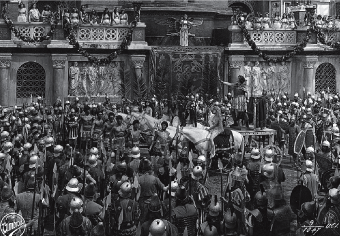Movies and Film: Turnin' to Turin
Turnin' to Turin
The Shroud of Turin, Jesus Christ's alleged burial cloth, isn't the only thing that established this small city as a famous name in Italy's long cultural history. While most of us think of Rome, Florence, and Milan when asked to name Italy's artistic centers, Turin became one of the true capitals of European filmmaking by 1910, and remained so through the outbreak of World War I.
Director's Cut
Despite the Italian name he adopted during his years in Turin, the great comedic actor Cretinetti was actually French by birth. Born Andr Chapuis in 1884, Andr Deed, as he later came to be known, made numerous slapstick flicks for Ambrosia, including Cretinetti alla Guerra (1909) and Cretinetti e le Donne (1915).
And indeed, for a while there it looked like the role would take. The peak of Italy's silent era, roughly 1910 to 1918, witnessed the rise of what would become the country's most dominant and recognized genre: the historical costume spectacle. Many of these films were truly innovative and outstanding. Quo Vadis (1912), directed by Enrico Guazzoni for Rome's Cines, featured huge crowds of extras and gigantic sets in its adaptation of the Nobel Prize-winning novel by the Polish writer Henryk Sienkiewicz. Giovanni Pastrone's monumental Cabiria (1914), made for the Turin company Itala, was the most grandiose film production to date, inspiring the great American director D. W. Griffith to expand his vision of what an epic film could be and featuring numerous innovations in camera movement and shot selection.

A shot from the 1919 Italian spectacle Theodora Empress of Byzantium.
Other directors, however, turned away from spectacle and sought to depict the workaday life of Italians. Febo Mari's L'emigrante (The Emigrant, 1915) and Emilio Ghione's I topi grigi (The Grey Rats, 1918) are excellent examples of this so-called "first wave" of Italian film realism that would culminate in "neorealism" after World War II.
The Wages of War
By the end of World War I, though, the Italian film business was hurting. Aside from the vast resources the economically bereft nation had to invest in the war (and thus drain from other sectors of life), competition from much more powerful American and European national industries put unprecedented pressure on Italian studios, and soon things simply dried up.
Although a few attempts were made at forging production and distribution monopolies or otherwise pumping money into the flagging industry, Italian film wouldn't see anything approaching a large-scale revival until several years after the Fascists came to power.
Director's Cut
It was hoped by many that MGM's decision to film the massively expensive Ben-Hur (1922) in Italy would breathe some life into the nation's industry, which was suffering greatly after World War I. By following the American example of pumping the big bucks into film production, industry leaders thought, Italian companies might revive an art form that had flourished before the war.
It wasn't to be. After numerous staffing and financial problems (including the firing of both the original director, Rex Ingram, and the star, George Walsh), real disaster struck. During the filming of sea battle sequences off the coast of Livorno, several accidents led to the deaths of a number of crew members, and the film eventually moved production out of Italy and back to Hollywood.
Filmophile's Lexicon
Divas, a term originally applied to opera heroines, were the sensuous, tragically beautiful, and passionate female leads of a subgenre of Italian film that dominated the screen during the 1920s. Women like Lyda Borelli, Rina De Liguoro, Pina Minichelli, Helena Makowska, and several others made dozens of stock melodramas that contributed greatly to the qualitative decline of Italian cinema during this period.
Excerpted from The Complete Idiot's Guide to Movies and Film © 2001 by Mark Winokur and Bruce Holsinger. All rights reserved including the right of reproduction in whole or in part in any form. Used by arrangement with Alpha Books, a member of Penguin Group (USA) Inc.
To order the e-book book direct from the publisher, visit the Penguin USA website. You can also purchase this book at Amazon.com.







